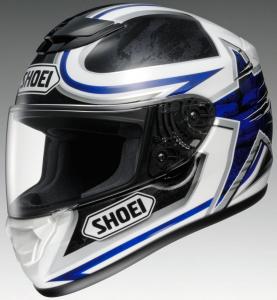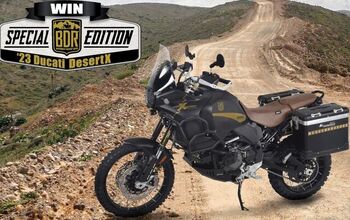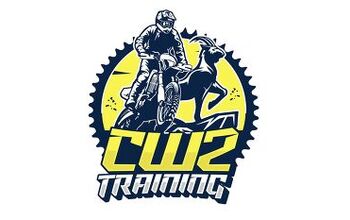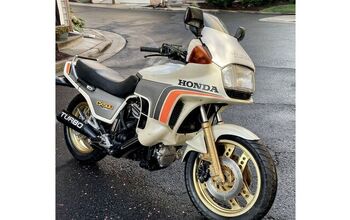2011 Shoei Qwest Helmet Review
Shoei’s Qwest is a touring helmet utilizing the same materials, construction and quality as the company’s RF-1100 high-performance-oriented helmet, and is functional for all kinds of street riding.
The Japanese helmet maker says it is the product of wind-tunnel testing, and was sculpted to be stable, balanced, and up to 2.2 decibels quieter than its previous touring helmet, the TZ-R.
In our testing, it seems to succeed on all counts, and to be sure, this is one quiet helmet.
An RF-1100-style neck roll and removable wind curtain under the chin bar helps muffle noise to the point that I’ve opted to forego earplugs on several rides recently, something I normally never do with other helmets I own.
At the same time, the Qwest allows “informative sounds” to get through while also letting in a good volume of fresh air via a large closable intake in the chin bar and on top.
Cooling air can be felt as it flows through ducts molded into the dual-density EPS liner, past the washable 3D comfort padding, and exits through two flush-fitting exhausts molded into the spoiler-shaped rear portion of the helmet. The cheek pads are easily removed for cleaning or fit revisions, but the center pad is fixed in its position.
Weight-wise, it’s in the same league as Pete’s recently reviewed RF-1100. A calibrated digital scale put a size small sample at 3 pounds, 10 ounces.
As a touring model, the Qwest was tested to cut and inhale air best while in an upright riding position - although frankly, it works with any bike.
The vents’ airflow also helps reduce fogging, but on humid or cool days, notching open the shield may still be needed. This is further facilitated by a “preset lever” on the left-side Q.R.S.A. (Quick Release Self-Adjusting) base plate that will also lock down the shield if desired.
The CW-1 shield – as used on the RF-1100 and race-oriented X-Twelve – is said to block 99% of UV rays, is spring loaded, pulls tight with a solid seal all the way around the gasket, and removes and installs easily without tools.
Peripheral vision and height of the opening is excellent. Shoei says the CW-1 is taller and wider than previous shields, and is available in an optional pinlock version. When wearing sunglasses, there’s no interference, and shield optics show no distortion.
Note also that the helmet has no tacked-on spoiler or other pieces protruding above the shell form. This integrated design was the result of techniques learned from development of the company’s off-road VFX-W – a helmet which last year was specifically mentioned by the late Harry Hurt as an exceptionally top-scoring helmet in impact tests done at his Head Protection Research Lab in Paramount, Calif.
No doubt, from an aerodynamic perspective, the lack of bits hanging in the air also help the Qwest cut cleanly and aerodynamically, and contributes to the sense that it offers negligible lift or drag until well above normal highway speeds.
The proprietary AIM+ Shell (same construction as RF-1100) is made of fiberglass and organic fibers, comes in five different shell sizes, and seven head sizes from XXS-XXL.
This many shell sizes lets the Qwest meet the Snell M2010 standard, which now takes into account the varying mass of different head sizes and weights.
Shoei says the Qwest’s inner shape is the same as that of its previous RF-1000. This is slightly more rounded than the RF-1100 (which replaced the 1000) or the X-Twelve, which is narrower and longer still.
As you probably know, the snuggest fit without discomfort is critical to a helmet’s performance. A loose helmet can be a hazard, and you ideally would want no space between skull and comfort liner in the event of a crash for best energy absorption.
As mentioned, my Qwest is a size small. I was initially tempted to trade up a size because there were a couple of hot spots on the sides of my head after half an hour or so where a hat brim might rest.
My alternative would have been a medium with thicker cheek pads – of which there are six sizes available. The thing is, I’ll use this for racing and track testing too – something Shoei says that while not optimal, is okay, as all its helmets are rated the same safety-wise.
In times past, helmet makers have been known to shave the Styrofoam inside of helmets from trackside to custom fit racers, and I was all set to do my own minor helmet surgery so I could keep the tighter fitting lid.
In examining the inside of the helmet, I noticed the EPS is very soft. So, well advised or not, instead of removing material, I merely used my fingers to push in a couple of very slight detents, maybe just two millimeters deep to speed up the break-in process, and this put me over the top in being comfortable full time. It was that close.
If it had been a lot of material to remove or crushed in, that would have compromised the helmet’s safety, but the degree I pushed was minimal – no more than would have happened on a normal break-in after more time.
I told Shoei’s rep, Bret Milan this, as he’d told me to expect the helmet to break in. While he did not endorse or condemn my expedient fix, he did tell me Shoei helmets can use softer impact-absorbing liner materials because the shell is extremely rigid, and he didn’t give any indication I’d compromised its protection.
In all, I think this interference fit was a better solution than wearing a too-large helmet, and sizing down the cheek pads.
Naturally, since no two heads are the same, my experience is unique, and you may like the fit, or not. As is true for any helmet, you’ll need to try it on yourself, preferably for several minutes if not a whole ride.
Another reason I was willing to do what it took was because, despite articles in the past few years suggesting it’s a total crap-shoot when picking the safest lid, I wanted this one to work because, after the research I’ve done, I believe Shoei makes a very high quality product.
For example, Hurt, who was a big fan of the DOT standard, wrote last year: “Our helmet testing during the last five or six years has shown one brand of helmets to show superior performance in DOT testing; Shoei helmets consistently show very low impact response and the highest crash protection, especially for the full facial coverage and modular helmets.”
Like all helmets legally sold in the U.S., Shoei helmets pass the DOT standard as well, but the point I took away was, if Shoei impressed the AMA Hall of Fame-recognized safety researcher, it’s good enough for me too.
The only nitpick I have is that the shield can rattle and blur vision a little if riding in buffeting air with the shield positioned up a couple notches for ventilation. The easy fix for this is to close it at these times, though it would be nice if this wasn’t necessary.
The helmet’s exterior finish is very smooth and durable as well. Even after following bikes closely on video shoots and test rides, and being pelted with random pebbles, the likes of which have chipped other helmets I’ve used, the Qwest is still looking pretty.
The Qwest comes with ear pockets for headset speakers for that growing number of you who want to chat via intercom or to listen to a GPS or music.
Part of the deal with Shoei includes a 5-year warranty, and knowledgeable people to answer the phone and help with issues. The company also does post-crash evaluation and even has a repair service – yes, did you know some minor hits do not automatically relegate a Shoei to mantle-ornament status?
For example, Milan says a helmet dropped onto a hard surface might not be damaged beyond safe usability. And cases in which helmets that have suffered abuse – such as when a customer’s dog turned the liner into a chew toy – also does not necessarily mean the bitter end.
Of course you should send any questionable helmet in to Shoei to determine its actual status, but in some cases, Shoei can replace not just the comfort padding, but even the EPS liner. Overall, Milan reports that more than half of Shoei’s customers’ helmets sent in for evaluation are returned and certified safe for continued use.
The Qwest comes in solid colors for $349.99, metallic colors for $369.99, and models with graphics go for $469.99. I picked the raciest color scheme possible, and for a “touring” helmet, it looks as aggressive as some of the RF-1100s. Naturally, I hope never to “fully” test it (against the pavement in a fall), but it’s good to know this lid is as high-tech as they come.
More info on the Qwest helmet can be found on Shoei’s website.
Related Reading
Shoei RF-1100 Helmet Review
2010 Arai Corsair V Helmet Review
2010 Icon Airframe Carbon Lifeform Helmet Review
Top Five Motorcycle Helmets From J.D. Power
Schuberth North America Opens its Doors
More by Jeff Cobb



































Comments
Join the conversation